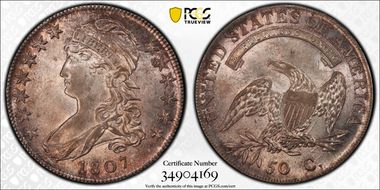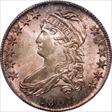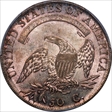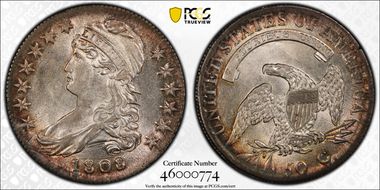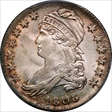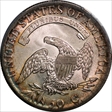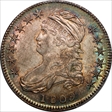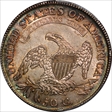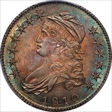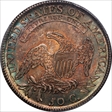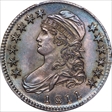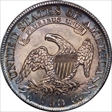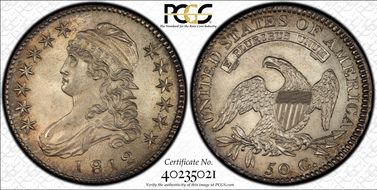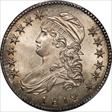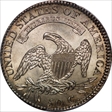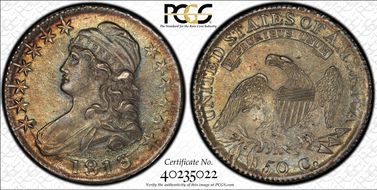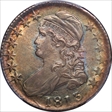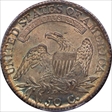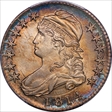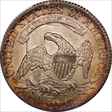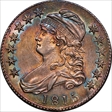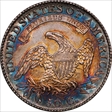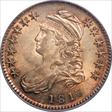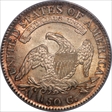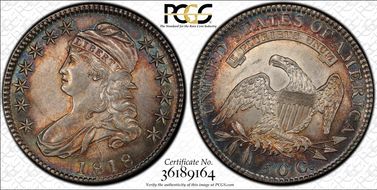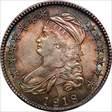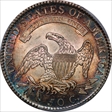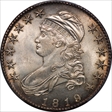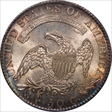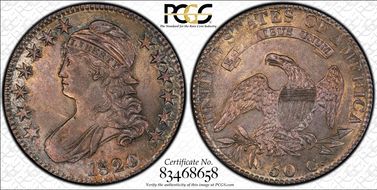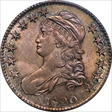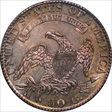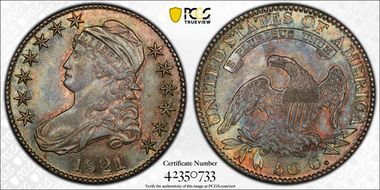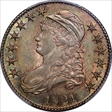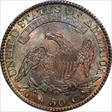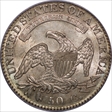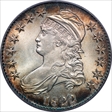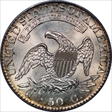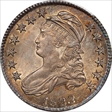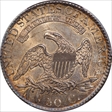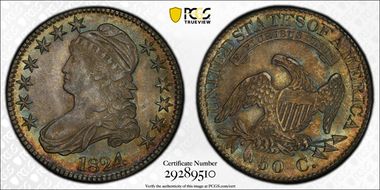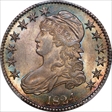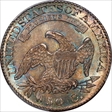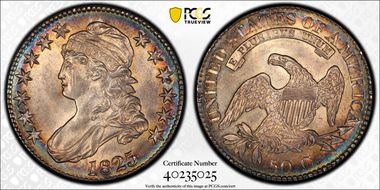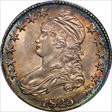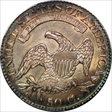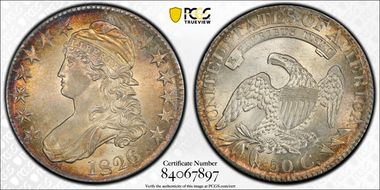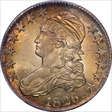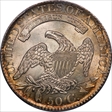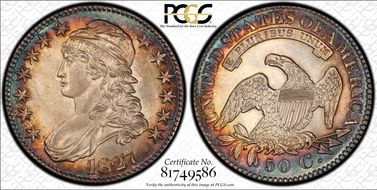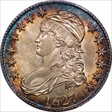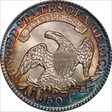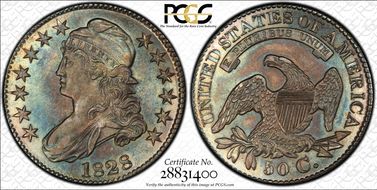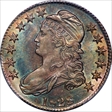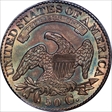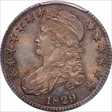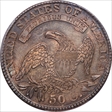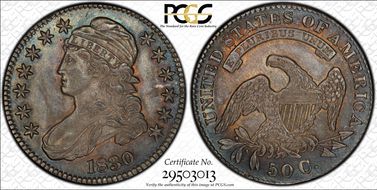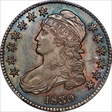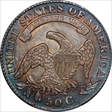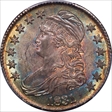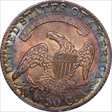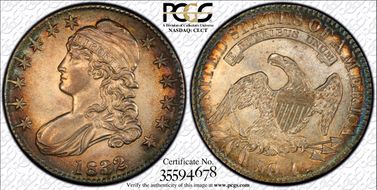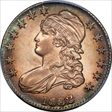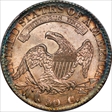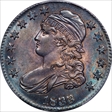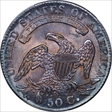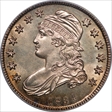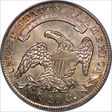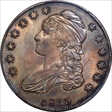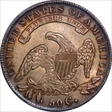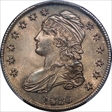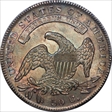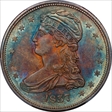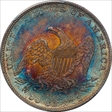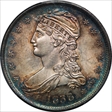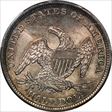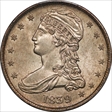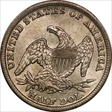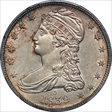The Coastal Collection (to '39) 的钱币相册
O.112, R1. CAC. Ex-Sears, ex-Osborne. Fabulous luster and flash.
O.112, R1. CAC. Ex-Sears, ex-Osborne. Fabulous luster and flash.
O.112, R1. CAC. Ex-Sears, ex-Osborne. Fabulous luster and flash.
O.103, R1. 1808 was the second year for Capped Bust Half dollars using design type #1 from the original hubs. As such pieces from 1808 share the same design as 1807 halves but also striking traits...typically weak in areas, and die deterioration...cracks and die failure due to both design (device location) and steel quality and hardening difficulties. With almost 1.4 million minted and many survivors of this early type, the 1808 is not rare. Higher grade survivors become scare at the AU level and higher. Ten die marriages are known with the O.110 being the most difficult to acquire (R4 ). The 1808/7 overdate is ever-popular as the first overdate of the CBH series.
O.103, R1. 1808 was the second year for Capped Bust Half dollars using design type #1 from the original hubs. As such pieces from 1808 share the same design as 1807 halves but also striking traits...typically weak in areas, and die deterioration...cracks and die failure due to both design (device location) and steel quality and hardening difficulties. With almost 1.4 million minted and many survivors of this early type, the 1808 is not rare. Higher grade survivors become scare at the AU level and higher. Ten die marriages are known with the O.110 being the most difficult to acquire (R4 ). The 1808/7 overdate is ever-popular as the first overdate of the CBH series.
O.103, R1. 1808 was the second year for Capped Bust Half dollars using design type #1 from the original hubs. As such pieces from 1808 share the same design as 1807 halves but also striking traits...typically weak in areas, and die deterioration...cracks and die failure due to both design (device location) and steel quality and hardening difficulties. With almost 1.4 million minted and many survivors of this early type, the 1808 is not rare. Higher grade survivors become scare at the AU level and higher. Ten die marriages are known with the O.110 being the most difficult to acquire (R4 ). The 1808/7 overdate is ever-popular as the first overdate of the CBH series.
O.107a, R3. CAC. This variety is notable, and was collected for its different edge lettering. For reasons we can only guess, four of 1809's 15 varieties have XXX characters stamped into the edge. Four other varieties used III inscriptions. (One variety, the O.108 shows both.) A good guess is that this was done to repair flawed die bars but no one really knows. According to Ivan Leaman and Donald Gunnet's 1986 report, Edges and Die Sequences on Early Half Dollars... ...three of the 1809 edges bear ornamentation and are called the experimental edges. The third edge exhibits heavy vertical grooves at the beginning of each bar in front of FIFTY and HALF. The fourth edge is called the engrailed edge. There is a series of X-like figures at the front of the first bar and at the end of the second. The sixth edge contains only 106. There are light grooves in the front of HALF. We call this the pseudo-engrailed edge.
O.107a, R3. CAC. This variety is notable, and was collected for its different edge lettering. For reasons we can only guess, four of 1809's 15 varieties have XXX characters stamped into the edge. Four other varieties used III inscriptions. (One variety, the O.108 shows both.) A good guess is that this was done to repair flawed die bars but no one really knows. According to Ivan Leaman and Donald Gunnet's 1986 report, Edges and Die Sequences on Early Half Dollars... ...three of the 1809 edges bear ornamentation and are called the experimental edges. The third edge exhibits heavy vertical grooves at the beginning of each bar in front of FIFTY and HALF. The fourth edge is called the engrailed edge. There is a series of X-like figures at the front of the first bar and at the end of the second. The sixth edge contains only 106. There are light grooves in the front of HALF. We call this the pseudo-engrailed edge.
O.109, R2. Catalogers comments: Ex Dr. Charles Link and so-noted on the PCGS label. A top-flight example that is sharply struck with extravagant luster. Liberty’s curls are amazing. Every strand is in bold relief. The eagle’s feathers are a match, distinct and unruffled. Largely untoned, though a gossamer veil of gold toning suggests recent storage in a Kraft envelope.
O.109, R2. Catalogers comments: Ex Dr. Charles Link and so-noted on the PCGS label. A top-flight example that is sharply struck with extravagant luster. Liberty’s curls are amazing. Every strand is in bold relief. The eagle’s feathers are a match, distinct and unruffled. Largely untoned, though a gossamer veil of gold toning suggests recent storage in a Kraft envelope.
O.109, R2. Catalogers comments: Ex Dr. Charles Link and so-noted on the PCGS label. A top-flight example that is sharply struck with extravagant luster. Liberty’s curls are amazing. Every strand is in bold relief. The eagle’s feathers are a match, distinct and unruffled. Largely untoned, though a gossamer veil of gold toning suggests recent storage in a Kraft envelope.
O.109, R3. LDS and probably equivalent to O.109a R5, the so-called single leaf. Through either excessive die wear or die lapping, as evidenced here, the 2nd leaf has been lost. On high grade specimens like this a trace of the 2nd leaf often shows.
O.109, R3. LDS and probably equivalent to O.109a R5, the so-called single leaf. Through either excessive die wear or die lapping, as evidenced here, the 2nd leaf has been lost. On high grade specimens like this a trace of the 2nd leaf often shows.
O.109, R3. LDS and probably equivalent to O.109a R5, the so-called single leaf. Through either excessive die wear or die lapping, as evidenced here, the 2nd leaf has been lost. On high grade specimens like this a trace of the 2nd leaf often shows.
O.101, R2. CAC. From the George Hamilton collection, lot 4093. Originally housed in an NGC old fattie graded AU55 with a CAC gold sticker. The catalog description: It is challenging to find an 1815/2 half dollar with any degree of eye appeal. They are by and large a dull lot, and many of the surviving pieces are impaired in one way or another. The present coin is a wonderful exception. Originally toned in attractive blue, violet, and tangerine-gold toning, both sides are brightly lustrous and sharply struck. Aside from the inevitable die clashing, there are no marks of consequence. Housed in an early generation NGC holder from about 25 years ago (with hologram but without the barcode), this Choice About Uncirculated coin carries the CAC gold sticker indicating it is undergraded by at least one level. An interesting bit of trivia about the 1815/2 is that the entire lot of coins struck in early Jan 1816 were paid out to a single customer: Jones, Firth and Co. How often can we trace provenance and know with certainty the original owner?
O.101, R2. CAC. From the George Hamilton collection, lot 4093. Originally housed in an NGC old fattie graded AU55 with a CAC gold sticker. The catalog description: It is challenging to find an 1815/2 half dollar with any degree of eye appeal. They are by and large a dull lot, and many of the surviving pieces are impaired in one way or another. The present coin is a wonderful exception. Originally toned in attractive blue, violet, and tangerine-gold toning, both sides are brightly lustrous and sharply struck. Aside from the inevitable die clashing, there are no marks of consequence. Housed in an early generation NGC holder from about 25 years ago (with hologram but without the barcode), this Choice About Uncirculated coin carries the CAC gold sticker indicating it is undergraded by at least one level. An interesting bit of trivia about the 1815/2 is that the entire lot of coins struck in early Jan 1816 were paid out to a single customer: Jones, Firth and Co. How often can we trace provenance and know with certainty the original owner?
O.113a, R4. OGH Cataloger's description: An intensely lustrous example with a ring of pastel rose and copper toning that floats through the stars and legend. Die breaks pass through and over the date. The surfaces are free of blemishes save for a short hairline at the tip of star 4. This is an eye-catching coin! From the Davignon Collection, acquired at Stack’s-Bowers’ Nov. 2012 Baltimore sale, lot 1676.
O.113a, R4. OGH Cataloger's description: An intensely lustrous example with a ring of pastel rose and copper toning that floats through the stars and legend. Die breaks pass through and over the date. The surfaces are free of blemishes save for a short hairline at the tip of star 4. This is an eye-catching coin! From the Davignon Collection, acquired at Stack’s-Bowers’ Nov. 2012 Baltimore sale, lot 1676.
O.115, R3. During 1819 the Mint struck a respectable 2.2 million half dollars using fifteen different die marriages. Five were overdates and ten, yeardates.
O.115, R3. During 1819 the Mint struck a respectable 2.2 million half dollars using fifteen different die marriages. Five were overdates and ten, yeardates.
O.107, R.5 From the Sept 2021 Legend Auction (H. Scharfman collection). Ex. Floyd Farley Collection; to Charlton (Swampy) Meyers circa 1996; Selected Rarities from the Meyer Collection, Sheridan Downey Mail Bid, July 2008, lot 32 (as NGC AU58); Dr. Charles Link Collection; sold via private treaty to Keith Davignon April 2010; private treaty sale to Dr. Charles Link (as PCGS AU58), March 2014; private treaty sale to our consignor, April 2017 Catalog description: An extremely difficult Rarity 5 die marriage, the O-107 is about on par with the 1812/1 Large 8 in terms of number known. Identifiable by broken A and E punches on the reverse, missing the serifs of both letters. This impressive, borderline Uncirculated example has one of the greatest pedigrees for the Capped Bust half dollar connoisseurs--it reads as a who's who of old time and recent Bust Half Nuts! Only the slightest hint of friction can be detected by a strong glass, indeed PCGS got it right grade wise. The underlying luster is bold, and while this coin may have been dipped ages ago, storage in an old Kraft envelope since that time has imparted a lovely pastel blue, gold, and rose tone. Generally very well struck up overall, we note just a touch of weakness at the tip of the bust. The eye appeal is sensational for this incredibly RARE variety. PCGS 1, NGC 0. This coin sold privately in 2017 for $46,500 and the Don Frederick AU58 sold privately in June 2020 for $56,000.
O.107, R.5 From the Sept 2021 Legend Auction (H. Scharfman collection). Ex. Floyd Farley Collection; to Charlton (Swampy) Meyers circa 1996; Selected Rarities from the Meyer Collection, Sheridan Downey Mail Bid, July 2008, lot 32 (as NGC AU58); Dr. Charles Link Collection; sold via private treaty to Keith Davignon April 2010; private treaty sale to Dr. Charles Link (as PCGS AU58), March 2014; private treaty sale to our consignor, April 2017 Catalog description: An extremely difficult Rarity 5 die marriage, the O-107 is about on par with the 1812/1 Large 8 in terms of number known. Identifiable by broken A and E punches on the reverse, missing the serifs of both letters. This impressive, borderline Uncirculated example has one of the greatest pedigrees for the Capped Bust half dollar connoisseurs--it reads as a who's who of old time and recent Bust Half Nuts! Only the slightest hint of friction can be detected by a strong glass, indeed PCGS got it right grade wise. The underlying luster is bold, and while this coin may have been dipped ages ago, storage in an old Kraft envelope since that time has imparted a lovely pastel blue, gold, and rose tone. Generally very well struck up overall, we note just a touch of weakness at the tip of the bust. The eye appeal is sensational for this incredibly RARE variety. PCGS 1, NGC 0. This coin sold privately in 2017 for $46,500 and the Don Frederick AU58 sold privately in June 2020 for $56,000.
O.107, R.5 From the Sept 2021 Legend Auction (H. Scharfman collection). Ex. Floyd Farley Collection; to Charlton (Swampy) Meyers circa 1996; Selected Rarities from the Meyer Collection, Sheridan Downey Mail Bid, July 2008, lot 32 (as NGC AU58); Dr. Charles Link Collection; sold via private treaty to Keith Davignon April 2010; private treaty sale to Dr. Charles Link (as PCGS AU58), March 2014; private treaty sale to our consignor, April 2017 Catalog description: An extremely difficult Rarity 5 die marriage, the O-107 is about on par with the 1812/1 Large 8 in terms of number known. Identifiable by broken A and E punches on the reverse, missing the serifs of both letters. This impressive, borderline Uncirculated example has one of the greatest pedigrees for the Capped Bust half dollar connoisseurs--it reads as a who's who of old time and recent Bust Half Nuts! Only the slightest hint of friction can be detected by a strong glass, indeed PCGS got it right grade wise. The underlying luster is bold, and while this coin may have been dipped ages ago, storage in an old Kraft envelope since that time has imparted a lovely pastel blue, gold, and rose tone. Generally very well struck up overall, we note just a touch of weakness at the tip of the bust. The eye appeal is sensational for this incredibly RARE variety. PCGS 1, NGC 0. This coin sold privately in 2017 for $46,500 and the Don Frederick AU58 sold privately in June 2020 for $56,000.
O.101a, R1. CAC. Provenance for this lovely half dollar dates back to violin virtuoso Jascha Heifetz. It was sold as part of his set by Superior Auctions in October 1989, lot 677, where it realized $3,960. In May 2008 it was sold by Heritage (Long Beach, 1108), lot 532, where it realized $3,738 as an NGC MS63, cert# 125439-008 (old fatty, no-line holder circa 1988-89). Ex Silbermünzen, Heifetz. Next is the Heritage 1173 (Philadelpha) sale in August 2012, lot 3392, where it realized $3,819 as PCGS MS63 (ex-Silberrmünzen), cert# 16142160. Finally it appeared in the Heritage 1329 (Dallas) sale in April 2021, lot 3465, where it realized $3,120 as PCGS MS63 (ex-Silbermünzen), cert. no. 28725897.
O.101a, R1. CAC. Provenance for this lovely half dollar dates back to violin virtuoso Jascha Heifetz. It was sold as part of his set by Superior Auctions in October 1989, lot 677, where it realized $3,960. In May 2008 it was sold by Heritage (Long Beach, 1108), lot 532, where it realized $3,738 as an NGC MS63, cert# 125439-008 (old fatty, no-line holder circa 1988-89). Ex Silbermünzen, Heifetz. Next is the Heritage 1173 (Philadelpha) sale in August 2012, lot 3392, where it realized $3,819 as PCGS MS63 (ex-Silberrmünzen), cert# 16142160. Finally it appeared in the Heritage 1329 (Dallas) sale in April 2021, lot 3465, where it realized $3,120 as PCGS MS63 (ex-Silbermünzen), cert. no. 28725897.
O.101a, R1. CAC. Provenance for this lovely half dollar dates back to violin virtuoso Jascha Heifetz. It was sold as part of his set by Superior Auctions in October 1989, lot 677, where it realized $3,960. In May 2008 it was sold by Heritage (Long Beach, 1108), lot 532, where it realized $3,738 as an NGC MS63, cert# 125439-008 (old fatty, no-line holder circa 1988-89). Ex Silbermünzen, Heifetz. Next is the Heritage 1173 (Philadelpha) sale in August 2012, lot 3392, where it realized $3,819 as PCGS MS63 (ex-Silberrmünzen), cert# 16142160. Finally it appeared in the Heritage 1329 (Dallas) sale in April 2021, lot 3465, where it realized $3,120 as PCGS MS63 (ex-Silbermünzen), cert. no. 28725897.
O.101a, R1. CAC. Provenance for this lovely half dollar dates back to violin virtuoso Jascha Heifetz. It was sold as part of his set by Superior Auctions in October 1989, lot 677, where it realized $3,960. In May 2008 it was sold by Heritage (Long Beach, 1108), lot 532, where it realized $3,738 as an NGC MS63, cert# 125439-008 (old fatty, no-line holder circa 1988-89). Ex Silbermünzen, Heifetz. Next is the Heritage 1173 (Philadelpha) sale in August 2012, lot 3392, where it realized $3,819 as PCGS MS63 (ex-Silberrmünzen), cert# 16142160. Finally it appeared in the Heritage 1329 (Dallas) sale in April 2021, lot 3465, where it realized $3,120 as PCGS MS63 (ex-Silbermünzen), cert. no. 28725897.
O.113, R3. NTS: regrade Cataloger's description: From the Davignon collection, found on the bourse floor during the 2003 ANA Convention. A blast of vibrant luster greets the eye. Frosty, untoned centers are framed with halos of russet toning. There is not a hint of friction on the devices; contact marks are virtually non-existent. The strike is first rate. In short, an ideal coin for an ambitious type or date collector. This was the last coin consigned to the sale. Keith uncovered and purchased an ethereal `22-113 at the recent Baltimore show. He explained, “[It] did indeed turn out to be a [George] Plimpton [family] Hoard coin. It was lot 700 in the 1981 NASCA sale of the Providence Collection, one of the 3 confirmed Plimpton Hoard auctions. I was able to identify it with 100% certainty from position of minor toning spots in the catalog photos.” Keith’s sleuthing and good fortune shook loose the coin offered here.
O.113, R3. NTS: regrade Cataloger's description: From the Davignon collection, found on the bourse floor during the 2003 ANA Convention. A blast of vibrant luster greets the eye. Frosty, untoned centers are framed with halos of russet toning. There is not a hint of friction on the devices; contact marks are virtually non-existent. The strike is first rate. In short, an ideal coin for an ambitious type or date collector. This was the last coin consigned to the sale. Keith uncovered and purchased an ethereal `22-113 at the recent Baltimore show. He explained, “[It] did indeed turn out to be a [George] Plimpton [family] Hoard coin. It was lot 700 in the 1981 NASCA sale of the Providence Collection, one of the 3 confirmed Plimpton Hoard auctions. I was able to identify it with 100% certainty from position of minor toning spots in the catalog photos.” Keith’s sleuthing and good fortune shook loose the coin offered here.
O.101a, R1. At some point Mint officials chose to touch up the WD that had been producing broken 3 varieties. The results would turn out less than graceful. The softened die was struck with a short blunt punch to impart a connection to the separated 3 pieces and the patched 3 was born. The die was placed back in service (O.101a) and later mated to a new reverse (O.102), giving us two die marriages. This example is one of the prettiest I have come across with its rose and amber central toning and blue rims with a touch of brick red. Full luster and clean surfaces give it strikingly strong eye appeal.
O.101a, R1. At some point Mint officials chose to touch up the WD that had been producing broken 3 varieties. The results would turn out less than graceful. The softened die was struck with a short blunt punch to impart a connection to the separated 3 pieces and the patched 3 was born. The die was placed back in service (O.101a) and later mated to a new reverse (O.102), giving us two die marriages. This example is one of the prettiest I have come across with its rose and amber central toning and blue rims with a touch of brick red. Full luster and clean surfaces give it strikingly strong eye appeal.
O.106, R4.Cataloger's notes: A flat-out stunning bust half-dollar! Vibrant luster and iridescent toning set the eye appeal rating at 10 out of 10. (Dr. Link’s private notes indicate “A+.”) There is a paucity of mint state examples of this R.4 die pair. Herrman lists the raw MS 65 prooflike Buddy Byers coin at no.1, placing the Link coin at no.2 in the Condition Census, tied (perhaps) with another MS 63 graded by ICG. You should preview this coin before bidding. Filched from my bourse case at the April 2013 Central States Show. Link provenance noted on the label.
O.106, R4.Cataloger's notes: A flat-out stunning bust half-dollar! Vibrant luster and iridescent toning set the eye appeal rating at 10 out of 10. (Dr. Link’s private notes indicate “A+.”) There is a paucity of mint state examples of this R.4 die pair. Herrman lists the raw MS 65 prooflike Buddy Byers coin at no.1, placing the Link coin at no.2 in the Condition Census, tied (perhaps) with another MS 63 graded by ICG. You should preview this coin before bidding. Filched from my bourse case at the April 2013 Central States Show. Link provenance noted on the label.
O.106, R4.Cataloger's notes: A flat-out stunning bust half-dollar! Vibrant luster and iridescent toning set the eye appeal rating at 10 out of 10. (Dr. Link’s private notes indicate “A+.”) There is a paucity of mint state examples of this R.4 die pair. Herrman lists the raw MS 65 prooflike Buddy Byers coin at no.1, placing the Link coin at no.2 in the Condition Census, tied (perhaps) with another MS 63 graded by ICG. You should preview this coin before bidding. Filched from my bourse case at the April 2013 Central States Show. Link provenance noted on the label.
O.111, R4. Catalog description: From the collection of Dr. Charles Link, noted on the PCGS label. Outrageous toning will draw oohs and ahs from those previewing the lot. Luster shimmers beneath a rainbow of iridescent colors. The surfaces are smooth as glass. And, yes, this IS an O.111, right behind the 1828 O.105 and 123 in the list of rare 1828’s. Cherry pickers look for the jagged die break joining the top drapery line to Liberty’s curls. Steve Herrman (AMBPR) identifies three other UNCs, providing assurance that this is a Condition Census offering. Its rarity in high grade is no secret.
O.111, R4. Catalog description: From the collection of Dr. Charles Link, noted on the PCGS label. Outrageous toning will draw oohs and ahs from those previewing the lot. Luster shimmers beneath a rainbow of iridescent colors. The surfaces are smooth as glass. And, yes, this IS an O.111, right behind the 1828 O.105 and 123 in the list of rare 1828’s. Cherry pickers look for the jagged die break joining the top drapery line to Liberty’s curls. Steve Herrman (AMBPR) identifies three other UNCs, providing assurance that this is a Condition Census offering. Its rarity in high grade is no secret.
O.111, R4. Catalog description: From the collection of Dr. Charles Link, noted on the PCGS label. Outrageous toning will draw oohs and ahs from those previewing the lot. Luster shimmers beneath a rainbow of iridescent colors. The surfaces are smooth as glass. And, yes, this IS an O.111, right behind the 1828 O.105 and 123 in the list of rare 1828’s. Cherry pickers look for the jagged die break joining the top drapery line to Liberty’s curls. Steve Herrman (AMBPR) identifies three other UNCs, providing assurance that this is a Condition Census offering. Its rarity in high grade is no secret.
O.105', R1. CAC. MB43 catalog description: This is a scrumptious MS63! Intense luster dances beneath the pastel gold toning. Very early die state, scarce as such. The central devices are razor sharp. Only stars 8 and 9 lack center points. All in all, a regal coin looking for a home in an important collection. ex-Link. Was NGC MS64 3164052-001
O.105', R1. CAC. MB43 catalog description: This is a scrumptious MS63! Intense luster dances beneath the pastel gold toning. Very early die state, scarce as such. The central devices are razor sharp. Only stars 8 and 9 lack center points. All in all, a regal coin looking for a home in an important collection. ex-Link. Was NGC MS64 3164052-001
O.114, R3. CAC. Catalog description: Flamboyant rainbow toning encircles both sides of this vibrant near-Gem half. Brightly lustrous, shades of amber-gold, sea-green, sky-blue, and lavender provide a dazzling display on both sides. Frosty luster beams from the finely granular surfaces, which show a scattering of light abrasions but no serious marks. The strike is sharp except on the eagle's right (facing) talons. CAC endorsed, the eye appeal is terrific. Tied for finest of the variety according to both the Steve Herrman and Donald Parsley census listings.
O.114, R3. CAC. Catalog description: Flamboyant rainbow toning encircles both sides of this vibrant near-Gem half. Brightly lustrous, shades of amber-gold, sea-green, sky-blue, and lavender provide a dazzling display on both sides. Frosty luster beams from the finely granular surfaces, which show a scattering of light abrasions but no serious marks. The strike is sharp except on the eagle's right (facing) talons. CAC endorsed, the eye appeal is terrific. Tied for finest of the variety according to both the Steve Herrman and Donald Parsley census listings.
O.114, R3. CAC. Catalog description: Flamboyant rainbow toning encircles both sides of this vibrant near-Gem half. Brightly lustrous, shades of amber-gold, sea-green, sky-blue, and lavender provide a dazzling display on both sides. Frosty luster beams from the finely granular surfaces, which show a scattering of light abrasions but no serious marks. The strike is sharp except on the eagle's right (facing) talons. CAC endorsed, the eye appeal is terrific. Tied for finest of the variety according to both the Steve Herrman and Donald Parsley census listings.
O.101a, R1. Ex-Dale Friend Aside from some oddities with chin/neck dots and laced lips, 1832 has one significant variety. The unique large letters reverse. It was the second to last die set used in 1832 ('33 used two '32 dies). The 101 LL variety is easy to spot. It has a large die break running through the left wing to where the tail meets the leaves.
O.101a, R1. Ex-Dale Friend Aside from some oddities with chin/neck dots and laced lips, 1832 has one significant variety. The unique large letters reverse. It was the second to last die set used in 1832 ('33 used two '32 dies). The 101 LL variety is easy to spot. It has a large die break running through the left wing to where the tail meets the leaves.
O.101a, R1. Ex-Dale Friend Aside from some oddities with chin/neck dots and laced lips, 1832 has one significant variety. The unique large letters reverse. It was the second to last die set used in 1832 ('33 used two '32 dies). The 101 LL variety is easy to spot. It has a large die break running through the left wing to where the tail meets the leaves.
O.109, R3. NTS: regrade Catalog description: Exquisite surfaces and a razor sharp strike justify the near gem designation. Light toning circles the stars and legend. The centers burst with unfettered luster. Look carefully at Liberty’s curls and drapery lines; then inspect the full, rounded feathers and claws of the eagle. If you demand the very best you’re on the right trail. From the collection of Dr. Charles Link.
O.109, R3. NTS: regrade Catalog description: Exquisite surfaces and a razor sharp strike justify the near gem designation. Light toning circles the stars and legend. The centers burst with unfettered luster. Look carefully at Liberty’s curls and drapery lines; then inspect the full, rounded feathers and claws of the eagle. If you demand the very best you’re on the right trail. From the collection of Dr. Charles Link.
GR-17 (JR-20), R1. One of the more common varieties and easily available. The obverse is normally well struck but the reverse, even in EDS, shows a significant die crack from 6 o'clock to 11. The reverse die in this example is counter clockwise rotated about 30 degrees. The half has remarkable, vivid toning emphasizing sea blue and green, soft magenta, and fiery orange.
GR-17 (JR-20), R1. One of the more common varieties and easily available. The obverse is normally well struck but the reverse, even in EDS, shows a significant die crack from 6 o'clock to 11. The reverse die in this example is counter clockwise rotated about 30 degrees. The half has remarkable, vivid toning emphasizing sea blue and green, soft magenta, and fiery orange.
GR-5, R2. A frosty, lustrous example of the last year in the series. Untoned and likely carefully dipped. Exceptional reverse strike and a weaker obverse. Some typical planchet roller marks but most subtle. (Was PCGS MS61, cert# 32919580)
GR-5, R2. A frosty, lustrous example of the last year in the series. Untoned and likely carefully dipped. Exceptional reverse strike and a weaker obverse. Some typical planchet roller marks but most subtle. (Was PCGS MS61, cert# 32919580)




















